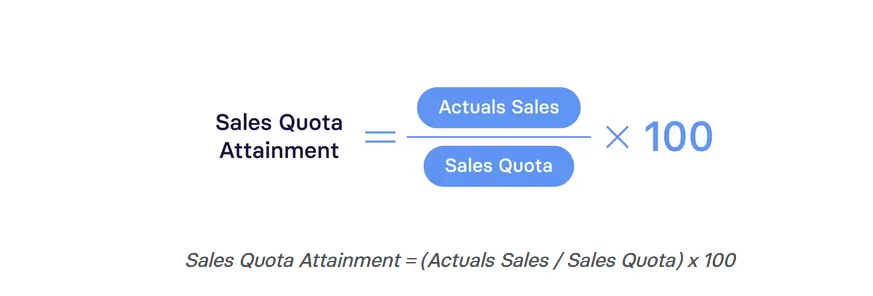Introduction to Quota Attainment

What is Quota Attainment?
Quota attainment is a critical metric used in sales to evaluate the effectiveness and efficiency of a sales team in meeting predetermined sales goals within a specific time frame. Understanding this concept is essential for any organization aiming to optimize its sales strategy.
Quota attainment measures the percentage of a sales quota that has been achieved by a sales representative or team.
The significance of quota attainment extends beyond mere numbers:
- Performance Indicator: It serves as a direct indicator of sales success. High quota attainment rates often correlate with strong sales performance and overall business growth.
- Motivational Tool: For sales teams, achieving or exceeding sales quotas can be highly motivating. Organizations often use these metrics to set benchmarks and incentivize performance with bonuses or commissions.
- Strategic Insights: Analyzing trends in quota attainment can help identify strengths and weaknesses in sales strategies, enabling more targeted improvements.
The Importance of Understanding Quota Attainment in Sales
Understanding quota attainment in sales is crucial for any business that relies on a sales force to drive revenue. It not only reflects the effectiveness of the sales team but also impacts the overall health of the company.
- Alignment with Business Goals: Quota attainment is closely tied to the strategic objectives of a company. Ensuring that sales teams are aligned with these goals through their quotas is essential for organizational success.
- Forecasting and Planning: Accurate quota attainment data helps businesses forecast future sales and make informed decisions about resource allocation. For instance, if a company has a consistent quota attainment rate of over 90%, it might plan to increase its targets or expand its sales team.
Here are several reasons why quota attainment is a critical focus area:
1. Employee Compensation: Many compensation plans are directly linked to quota attainment. Sales representatives who meet or exceed their quotas typically earn commissions or bonuses, serving as a powerful motivator.
2. Market Competitiveness: Staying competitive in the market often requires maintaining or improving quota attainment rates. Companies with high attainment rates are better positioned to take advantage of market opportunities.
3. Operational Efficiency: Understanding and optimizing quota attainment can lead to more efficient sales operations. For example, data from CSO Insights shows that companies with high quota attainment rates also tend to have streamlined sales process and better sales rep retention rates.
How to Calculate Quota Attainment
Calculating quota attainment is a straightforward yet vital process in sales management. It determines how well a salesperson or team is performing relative to their sales targets, which are set based on the company’s goals and market conditions.
Basic Formula: Quota attainment is calculated by dividing the actual sales achieved by the sales quota and then multiplying by 100 to express it as a percentage.
- Example: If a salesperson's quota is $100,000 and they sell $75,000, their quota attainment would be 75,000/100,000 × 100= 75.

Understanding average quota attainment across the team or organization provides additional insights:
- Industry Benchmarks: According to research, the average quota attainment across various industries typically ranges between 50% to 70%. This benchmark helps companies assess the competitiveness and effectiveness of their sales force.
- Goal Setting: Companies often set quotas at a level where a majority of the sales force is expected to achieve between 80% to 100% attainment. Achieving or exceeding 100% is usually rewarded with additional incentives.
Average Quota Attainment: Benchmarks
Comparative Analysis: Average quota attainment allows managers to compare individual performance against team averages and industry standards, facilitating more targeted coaching and support.
Strategic Adjustments: If the average quota attainment is consistently below the industry benchmark, it might indicate an overly aggressive sales target or a need for improved sales training and resources.
Incentive Planning: Companies can use these benchmarks to plan effective compensation strategies that motivate sales teams while aligning with company profitability.
Reasons Your Sales Team Is Falling Short of Sales Quotas

When a sales team consistently falls short of meeting its sales quotas, it's crucial to identify the underlying causes to address these issues effectively. Understanding these reasons can help in restructuring strategies and improving sales performance.
Here are some common reasons why sales teams may not meet their sales quotas:
1. Unrealistic Quota Setting
If quotas are set without a realistic understanding of market conditions and historical sales data, teams might find them unachievable. For instance, if a sudden increase in quota of 30% is set without corresponding market growth, sales teams might struggle.
2. Inadequate Sales Training
Continuous training is crucial for sales success. A CSO Insights study shows that companies with comprehensive training programs have 13% more sales reps achieving their quotas.
3. Lack of Adequate Resources
Sales teams need the right tools to succeed, from CRM software to lead generation support. Lack of these can hinder their ability to close deals effectively.
4. Poor Lead Quality
If the marketing team provides leads that are not well-qualified, sales reps will spend more time on leads with a lower chance of conversion. Data shows that high-quality leads increase conversion rates by up to 70%.
5. Ineffective Sales Strategies
Without a clear and effective sales strategy, sales teams might not be able to prioritize or know how to approach potential deals effectively. This strategic misalignment can lead to wasted efforts and missed quotas.
6. Internal Communication Issues
Poor communication between sales managers and their teams can lead to misaligned goals and strategies. For instance, if sales reps are not clear on the criteria or strategic importance of certain quotas, their approach to achieving them might be inefficient.
External Market Factors
Changes in the market or economy, such as new competitors or economic downturns, can also affect quota attainment. It’s vital to adjust quotas and strategies in response to such external factors.
How to Improve Performance and Achieve Sales Quotas

Improving performance and achieving sales quotas are essential goals for any sales team. Here are five effective tactics to enhance sales performance and ensure quotas are not just met but exceeded:
1. Tailor Quotas to Specific Roles
Customized Approach: Avoid using a "one-size-fits-all" strategy for setting sales quotas. Tailoring quotas to the specific roles and responsibilities within your team can lead to higher attainment rates. For instance, research shows that differentiated quotas can increase quota attainment by up to 14% compared to a uniform quota system.
2. Offer Uncapped Commissions
Incentive Structure: Implementing uncapped commissions motivates sales reps to exceed their targets. When reps know that their earning potential is not limited, they are more likely to push beyond the 100% quota mark, maximizing sales efforts and driving greater revenue.
3. Account for Ramp-Up Time for New Hires
Realistic Expectations: New sales reps need time to learn and adapt. Setting realistic ramp-up periods and adjusting quotas accordingly ensures that new hires are not overwhelmed and can progressively achieve full productivity. This approach not only aids in retention but also builds a more competent sales planning process.
4. Enhance Training and Coaching Programs
Continuous Development: Regular and tailored training programs are crucial for both new and experienced sales leaders. Engaging training materials and effective coaching lead to better preparedness and higher sales performance. Studies indicate that enhanced training can significantly reduce turnover and increase quota attainment across the team.
5. Benchmark and Optimize Incentives Using Industry Data
Strategic Adjustments: Regularly bench marking your incentive plans against industry standards allows for continuous improvement and competitive positioning. Adjusting your strategies based on reliable industry data ensures that your compensation packages are attractive and equitable, helping retain top talent and drive better sales efforts.
Concluding Thoughts
In conclusion, understanding and optimizing quota attainment is pivotal for any sales organization aiming to maximize efficiency and effectiveness. By implementing strategic practices such as tailoring quotas to specific roles, offering uncapped commissions, and accounting for new hire ramp-up times, businesses can significantly enhance their ability to not only meet but exceed sales quotas.
Additionally, ongoing training for sales leaders and the strategic use of industry data to benchmark and optimize incentives are essential for maintaining competitive edge and ensuring continuous improvement. Through these methods, organizations can better measure quota attainment and drive their sales teams towards greater success.









